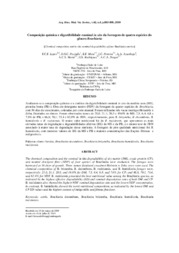Composição química e digestibilidade ruminal in situ da forragem de quatro espécies do gênero Brachiaria.
Composição química e digestibilidade ruminal in situ da forragem de quatro espécies do gênero Brachiaria.
Author(s): LOPES, F. C. F.; PACIULLO, D. S. C.; MOTA, E. F.; PEREIRA, J. C.; AZAMBUJA, A. A. de; MOTTA, A. C. S.; RODRIGUES, G. S.; DUQUE, A. C. A.
Summary: RESUMO - Avaliaram-se a composição química e a cinética da digestibilidade ruminal in situ da matéria seca (MS), proteína bruta (PB) e fibra em detergente neutro (FDN) da forragem de quatro espécies de Brachiaria, com 56 dias de crescimento, coletadas por corte manual. Foram utilizadas três vacas mestiças Holandês x Zebu, fistuladas no rúmen. Foram observados teores de 21,0; 21,1; 20,5 e 19,6% de MS; 7,5; 6,4; 6,8 e 7,0% de PB; e 66,8; 70,1; 73,4 e 63,9% de FDN, respectivamente, para B. brizantha, B. decumbens, B. humidicola e B. ruziziensis. O maior valor nutricional foi da B. ruziziensis, que apresentou as mais elevadas taxas de degradação e degradabilidades efetivas (DE) da MS e da PB, e o menor teor de FDN associado à maior taxa de degradação desse nutriente. A forragem de pior qualidade nutricional foi B. humidicola, com menores valores de DE da MS e PB e maiores concentrações das frações fibrosas e indigestíveis. ABSTRACT - The chemical composition and the ruminal in situ degradability of dry matter (DM), crude protein (CP), and neutral detergent fiber (NDF) of four species of Brachiaria were evaluated. The forages were harvested at 56 days of growth. Three rumen-fistulated crossbred Holstein × Zebu cows were used. The chemical composition of B. brizantha, B. decumbens, B. ruziziensis, and B. humidicola forages were, respectively: 21.0, 21.1, 20.5, and 19.6% for DM; 7.5, 6.4, 6.8, and 7.0% for CP; and 66.8, 70.1, 73.4, and 63.9% for NDF. B. ruziziensis presented the best nutritional value among the Brachiaria species, as indicated by the highest effective degradability (ED) and ruminal degradation rates of both DM and CP. B. ruziziensis also showed the highest NDF ruminal degradation rate and the lowest NDF concentration. In contrast, B. humidicola showed the worst nutritional composition, as indicated by the lowest DM and CP ED values and the highest content of indigestible and fibrous fractions.
Publication year: 2010
Types of publication: Journal article
Unit: Embrapa Dairy Cattle
Observation
Some of Embrapa's publications are published as ePub files. To read them, use or download one of the following free software options to your computer or mobile device. Android: Google Play Books; IOS: iBooks; Windows and Linux: Calibre.
Access other publications
Access the Agricultural Research Database (BDPA) to consult Embrapa's full library collection and records.
Visit Embrapa Bookstore to purchase books and other publications sold by Embrapa.

